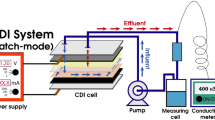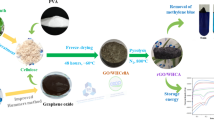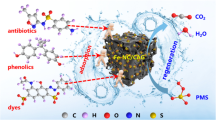Abstract
Nowadays, environmental pollution due to centralized industrialization has occurred rapidly around the world; thus, efficient remediation is in dire requirement. In this literature, the carbon aerogel material was fabricated using the lotus receptacle (LCA) via a hydrothermal treatment and N2-atmosphere pyrolysis. Characterization was conducted using various solid phase analyses to confirm the successful upcycling of carbon aerogel from the mentioned waste by-product. The synthesized material was consequently applied for the adsorption of diesel oil and methylene blue, yielding up to 80 and 99% removal efficiency for the two contaminants, respectively, wherein several factors such as the absorbent dose and dye concentration as well as the adsorption kinetic were also assessed. Besides, the electrochemical properties were additionally assessed to consummate the application of the material in the electrochemical field, which reveals the promising applicability of the fabricated LCA not only as an efficient adsorbent for wastewater treatment but also as a good capacitor with great sustainability even after 500 consecutive charging–discharging cycles.
Graphical abstract











Similar content being viewed by others
References
Hojjati-Najafabadi A, Mansoorianfar M, Liang T et al (2022) A review on magnetic sensors for monitoring of hazardous pollutants in water resources. Sci Total Environ 824:153844. https://doi.org/10.1016/j.scitotenv.2022.153844
Velusamy S, Roy A, Sundaram S, Kumar Mallick T (2021) A review on heavy metal ions and containing dyes removal through graphene oxide-based adsorption strategies for textile wastewater treatment. Chem Rec 21:1570–1610. https://doi.org/10.1002/tcr.202000153
Hafizur RM, Nuralam HM, Rumainul IM (2017) Investigation of physicochemical parameter, heavy metal in Turag river water and adjacent industrial effluent in Bangladesh. J Sci Technol Environ Inform 5:347–360. https://doi.org/10.18801/jstei.050117.37
Junfeng W, Yilin W, Xiaofei Z et al (2020) Technologies of removal of organics in reverse osmosis concentrates from petroleum refinery wastewater. Progress Chem 32:1462
Pirhashemi M, Habibi-Yangjeh A, Rahim Pouran S (2018) Review on the criteria anticipated for the fabrication of highly efficient ZnO-based visible-light-driven photocatalysts. J Ind Eng Chem 62:1–25. https://doi.org/10.1016/j.jiec.2018.01.012
Samanta P, Desai AV, Let S, Ghosh SK (2019) Advanced porous materials for sensing, capture and detoxification of organic pollutants toward water remediation. ACS Sustain Chem Eng 7:7456–7478. https://doi.org/10.1021/acssuschemeng.9b00155
De France KJ, Hoare T, Cranston ED (2017) Review of hydrogels and aerogels containing nanocellulose. Chem Mater 29:4609–4631. https://doi.org/10.1021/acs.chemmater.7b00531
Sun S, Yan Q, Wu M, Zhao X (2021) Carbon aerogel based materials for secondary batteries. Sustain Mater Technol 30:e00342. https://doi.org/10.1016/j.susmat.2021.e00342
Liu Y, Liu J, Song P (2021) Recent advances in polysaccharide-based carbon aerogels for environmental remediation and sustainable energy. Sustain Mater Technol 27:e00240. https://doi.org/10.1016/j.susmat.2020.e00240
Shahrajabian MH, Sun W, Cheng Q, Khoshkharam M (2022) Exploring the quality of foods from ancient China based on traditional Chinese medicine. In: Functional foods and nutraceuticals in metabolic and non-communicable diseases. Elsevier, Amsterdam, pp 87–105
Arooj M, Imran S, Inam-ur-Raheem M et al (2021) Lotus seeds (Nelumbinis semen) as an emerging therapeutic seed: a comprehensive review. Food Sci Nutr 9:3971–3987. https://doi.org/10.1002/fsn3.2313
Gardetti MA, Muthu SS (2015) The lotus flower fiber and sustainable luxury. Handb Sustain Luxury Text Fashion 1:3–18. https://doi.org/10.1007/978-981-287-633-1_1
Tin NT, Huyen NTT, Tu PM et al (2023) Facile fabrication of carbon aerogel by cellulose extracted from tea grounds and carboxymethyl cellulose for adsorption and energy storage applications. Mater Lett 342:134304. https://doi.org/10.1016/j.matlet.2023.134304
Lam CV, Vy DNC, Duyen NHK et al (2024) Zinc oxide-doped carbon aerogel derived from bagasse cellulose/sodium alginate/zinc nitrate composite for dye adsorption, storage energy and electrochemical sensing. J Chem Technol Biotechnol 99:279–293. https://doi.org/10.1002/jctb.7536
Xiao D, He M, Liu Y et al (2020) Strong alginate/reduced graphene oxide composite hydrogels with enhanced dye adsorption performance. Polym Bull 77:6609–6623. https://doi.org/10.1007/s00289-020-03105-7
Nazari M, Rahmanifar MS, Noori A et al (2021) The ordered mesoporous carbon nitride-graphene aerogel nanocomposite for high-performance supercapacitors. J Power Sources 494:229741. https://doi.org/10.1016/j.jpowsour.2021.229741
Hou C-H, Taboada-Serrano P, Yiacoumi S, Tsouris C (2008) Electrosorption selectivity of ions from mixtures of electrolytes inside nanopores. J Chem Phys 129. https://doi.org/10.1063/1.3033562
Yin N, Ai Y, Xu Y et al (2020) Preparation of magnetic biomass-carbon aerogel and its application for adsorption of uranium(VI). J Radioanal Nucl Chem 326:1307–1321. https://doi.org/10.1007/s10967-020-07392-2
Wang Y, Zhu L, Zhu F et al (2017) Removal of organic solvents/oils using carbon aerogels derived from waste durian shell. J Taiwan Inst Chem Eng 78:351–358. https://doi.org/10.1016/j.jtice.2017.06.037
Ashraf MA, Maah MJ, Yusoff I (2011) Heavy metals accumulation in plants growing in ex tin mining catchment. Int J Environ Sci Technol 8:401–416. https://doi.org/10.1007/BF03326227
Wang M, Shao C, Zhou S et al (2017) Preparation of carbon aerogels from TEMPO-oxidized cellulose nanofibers for organic solvents absorption. RSC Adv 7:38220–38230. https://doi.org/10.1039/C7RA05506D
Wu X, Wu D, Fu R (2007) Studies on the adsorption of reactive brilliant red X-3B dye on organic and carbon aerogels. J Hazard Mater 147:1028–1036. https://doi.org/10.1016/j.jhazmat.2007.01.139
Islam MdA, Sabar S, Benhouria A et al (2017) Nanoporous activated carbon prepared from karanj (Pongamia pinnata) fruit hulls for methylene blue adsorption. J Taiwan Inst Chem Eng 74:96–104. https://doi.org/10.1016/j.jtice.2017.01.016
Kittappa S, Jais FM, Ramalingam M et al (2020) Functionalized magnetic mesoporous palm shell activated carbon for enhanced removal of azo dyes. J Environ Chem Eng 8:104081. https://doi.org/10.1016/j.jece.2020.104081
Tu PM, Minh DTC, Lam CV et al (2023) Nipa palm shell-derived magnetic carbon aerogel for absorbents and storage energy. J Non Cryst Solids 615:122424. https://doi.org/10.1016/j.jnoncrysol.2023.122424
Wang X, Liu L, Wang X et al (2011) Preparation and performances of carbon aerogel microspheres for the application of supercapacitor. J Solid State Electrochem 15:643–648. https://doi.org/10.1007/s10008-010-1142-5
Xu J, Zhou X, Chen M et al (2018) Preparing hierarchical porous carbon aerogels based on enzymatic hydrolysis lignin through ambient drying for supercapacitor electrodes. Microporous Mesoporous Mater 265:258–265. https://doi.org/10.1016/j.micromeso.2018.02.024
Lv C, Ma X, Guo R et al (2023) Polypyrrole-decorated hierarchical carbon aerogel from liquefied wood enabling high energy density and capacitance supercapacitor. Energy 270:126830. https://doi.org/10.1016/j.energy.2023.126830
Acknowledgements
We acknowledge the support of time and facilities from Ho Chi Minh City University of Technology (HCMUT), VNU-HCM for this study.
Author information
Authors and Affiliations
Corresponding author
Additional information
Publisher's Note
Springer Nature remains neutral with regard to jurisdictional claims in published maps and institutional affiliations.
Rights and permissions
Springer Nature or its licensor (e.g. a society or other partner) holds exclusive rights to this article under a publishing agreement with the author(s) or other rightsholder(s); author self-archiving of the accepted manuscript version of this article is solely governed by the terms of such publishing agreement and applicable law.
About this article
Cite this article
An, H., Lin, T.H., Buu, T.T. et al. Upcycling the lotus receptacle for the synthesis of carbon aerogel for adsorption and electrochemical properties. Polym. Bull. (2024). https://doi.org/10.1007/s00289-024-05184-2
Received:
Revised:
Accepted:
Published:
DOI: https://doi.org/10.1007/s00289-024-05184-2




